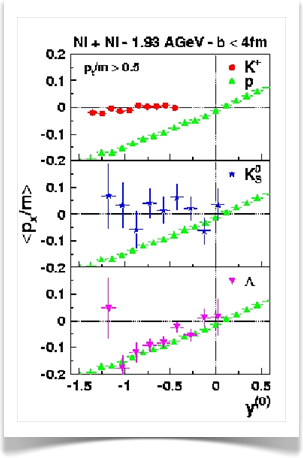

FOPI
A Detector for Physics of Nuclear Reactions at Intermediate and Relativistic Energies

Directed Sidewards Flow
Due to the conservation of strangeness, at beam energies of less than 2 GeV per nucleon kaons are produced together with L-particles. The particles are thus produced at the same location, and interaction with the surrounding matter is for all differences observed in the detector. It therefore follows from the distributions shown in Figure 8, that kaons are repelled of high baryon density, while L -particles are drawn in to these regions. It should, however, be noted that K+- meson to the L-particles, can leave the reaction volume relatively undisturbed-at least that is what the properties of the free particles seem to indicate.
Due to the conservation of strangeness, at beam energies of less than 2 GeV per nucleon kaons are produced together with L-particles. The particles are thus produced at the same location, and interaction with the surrounding matter is for all differences observed in the detector. It therefore follows from the distributions shown in Figure 8, that kaons are repelled of high baryon density, while L -particles are drawn in to these regions. It should, however, be noted that K+- meson to the L-particles, can leave the reaction volume relatively undisturbed-at least that is what the properties of the free particles seem to indicate.

The average values of the projection of the transverse momentum in the reaction plane are a function of the normalized rapidity y(0), which represents a measure of the velocity along the beam direction. These average value of the directed sidewards flow. The main flow axis is determined by the protons (green histogram). Differences between the L-(bottom) and K0 (middle) and the positive kaons (top) relative to the protons allow conclusions concerning the interaction with the surrounding medium.
In the lower part of Figure 8, measurements are compared with theoretical calculations [1] which investigated both the free interaction and different versions of the "in-medium interaction" of kaons with the surrounding matter. In the simplest case, corresponding to the dotted line, the kaons should simply not notice the presence of the nucleons. A flow signal in the nucleon direction is to be expected in this case. If an interaction, which can be expressed by a potential, is taken into account, then according to intensity and type, there is agreement with the measured values. The case in which the lateral flow data are described corresponds to the phenomenon of reduced mass mentioned at the start of this section: an attractives calar potential is required in order to compensate, at least partially, for the strongly repulsivev ector potential. Within the context of chiral models, such scalar potentials havec learly-defined effects on the masses of a very wide range of particles.
One possible explanation in the context of a transport calculation [1] is offered by the theoretical predictions shown in the diagram for the cases: no potential (dotted), repulsive vector potential (broken line), and scalar and vector potential (continuous line).
One possible explanation in the context of a transport calculation [1] is offered by the theoretical predictions shown in the diagram for the cases: no potential (dotted), repulsive vector potential (broken line), and scalar and vector potential (continuous line).
In particular, these hypotheses lead to significant differences between K+ and K--mesons, both in the probability of production and in the flow characteristics. However, such investigations are considerably more difficult, as K--mesons appear less frequently. Such measurements are currently being undertaken, along with the measurement of more exotic, higher-mass particles, such as the y-mesons. The first results on the flow characteristics of the antikaons appear to fit with the theoretical predictions of the "chiral" model. However, evaluation is not yet complete. The current FOPI experiment program is expected to produce additional interesting information on the character of the interaction in hot, compressed nuclear matter.
References:
1. G.Q. Li und C.M. Ko, Nucl. Phys. A594, 460 (1995)
1. G.Q. Li und C.M. Ko, Nucl. Phys. A594, 460 (1995)